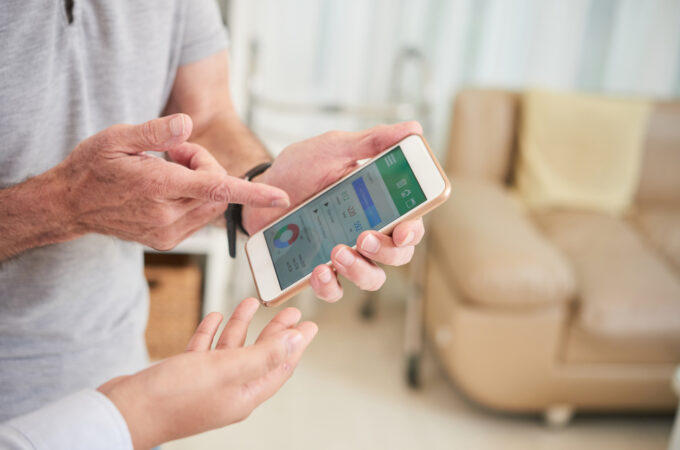Many older people are choosing the option of ‘aging in place’ at home, and as they age, some will have complex health care and personal care needs. To effectively plan for care and manage the care journey, the person responsible for managing their care will need easy access to secure online health information that is available anywhere, anytime, on any device.
The previous blog in this series, entitled Aging in Place: Who Coordinates the Coordinators in Complex Care? explored the challenges of caring for a family member who wishes to remain at home. The family becomes the de facto care coordinator and manager. Many families or attorneys for personal care simply do not have the time or expertise to manage these ‘care in the home’ situations and find it challenging, stressful and time-consuming to manage the various care providers and coordinators involved.
Effectively managing and coordinating home care will depend on accurate and timely health information. For example, an elderly frail and bedbound 90-year-old woman may have a suspected urinary tract infection. A visiting healthcare provider decides to do bloodwork and urine tests in the home. If the family member has access to online health information, they can receive test results and discuss treatment with the care provider, all without the person needing to attend a doctor’s office or hospital clinic.
The value of access to online health information has been studied for some time. There is an international consensus from the G7 countries identifying how important it is for patients and caregivers to access online health information[1]. The work indicated that a patient’s right to access their health information will:
- help empower patients to take an active part in managing their health and care
- support improvements in individuals’ health outcomes and
- enable patients to ensure that clinicians have key relevant information about them before they start their treatment.
Getting access to your health information in Canada is still a work in progress. Last year, Canada Health Infoway reported that 32 percent of Canadians indicated they had accessed their health information online. That’s a considerable increase from the 4 percent who reported in 2014 but does not come close to 80 percent of Canadians who want easy, secure electronic access to their health information[2].
In McInerney v. MacDonald, [1992] 2 S.C.R. 138, the Supreme Court clarified that the medical and health information in an electronic medical record belongs to the patient, and they have “…a right to see the content of their record at any time and for any reasons.” However, the decision also noted that the actual record or system belonged to the organization or physician. Today, there continue to be obstacles for patients accessing their records.
There is no national electronic health record for each Canadian. Depending on the province, there may be different provincial portals for their residents:
- Health Gateway in British Columbia
- MyHealthAlberta in Alberta
- MySaskHealthRecord in Saskatchewan
- Carnet Sante’ in Quebec
- MyHealthNB in New Brunswick
In Ontario, some hospitals and provider organizations have implemented patient portals allowing patients to access their online health data within that health care organization.
- MyUHN Patient Portal (University Health Network) includes Toronto General Hospital, Toronto Western Hospital, Toronto Rehabilitation Institute, and Princess Margaret Hospital.
- My Health Record Portal (Women’s College Hospital, Toronto)
- MyChart (Sunnybrook Health Sciences Hospital)
The MyChart portal is owned and operated by Sunnybrook Health Sciences Hospital. Several hospitals in the Greater Toronto area and other areas of the province are using this online website for patients to access online health information. Each hospital using MyChart encourages their patients to register for online health information using the interactive online tool where the patient can add certain information. They can also share access with family members, caregivers, and other healthcare providers. Some areas of information include:
- Track appointments, healthcare providers, medications, follow-up instructions and more.
- See notes and summaries from clinic and hospital visits
- Schedule and track appointments. Attend video appointments
- View test results
- Update your information and health-related pictures before visits
- List your medications and track changes, allergies, and vaccinations
- Track medical information, like blood pressure or blood sugar
- Read health education materials
- Pay bills and view receipts[3]
While progress is being made for patients to access online hospital-based health information, hospitals are only one part of a multifaceted healthcare environment. ‘Aging in place’ at home will require connectedness to all the various stakeholders – family caregivers, family doctors, health providers, home care providers, and others. Some providers may have online health records or patient portals, but they do not interoperate with the hospital’s online portal or each other.
Advisors helping their clients plan to ‘age in place’ need to consider who will be managing the more complex care situations and how they will get easy access to secure online health information available anywhere, anytime, on any device.
[1] https://www.g7.utoronto.ca/healthmins/2021-patient-access.html
[2] https://www.echima.ca/patient-access-to-their-health-information-how-far-have-we-come/
[3] https://www.hamiltonhealthsciences.ca/patients-visitors/digital-health-care/mychart/


0 Comments